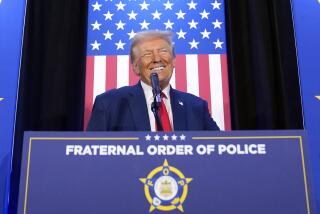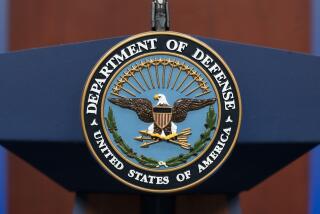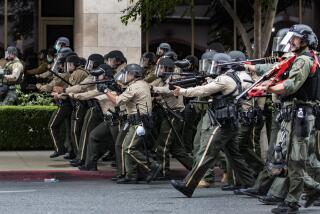Trump calls for improved police hiring and training

President Trump shows off signature on an executive order on policing on Tuesday.
WASHINGTON — President Trump signed an executive order Tuesday that seeks to leverage federal grants to improve police training and hiring, but the limited measures fell far short of addressing widespread demands for deep reforms to prevent recurring abuse of Black people.
Although Trump said he would ban chokeholds unless an officer’s life was in danger, the order he signed in a Rose Garden ceremony is noticeably less restrictive.
It says chokeholds should not be used “except in those situations where the use of deadly force is allowed by law,” which is consistent with current police policy in many jurisdictions.
Seattle, Houston, San Diego, Denver and other cities have moved to ban or severely restrict the use of chokeholds since the police killing of George Floyd, a Black man in Minneapolis, on May 25, sparked protests across the country.
Trump also directed Atty. Gen. William Barr to create a database to track police abuses, and to provide incentives for officers to work more with social workers when dealing with mental health emergencies.
The order requires local police departments to tighten their policies to access certain Justice Department grants. Trump has little direct authority over local policing practices.
House Democrats are pushing a bill that contains sweeping proposals for police reforms. Senate Republicans are preparing their own legislation, but it’s unclear when it will be released.
Trump has said he was disturbed by the video of a white police officer kneeling on Floyd’s neck for nearly nine minutes, the catalyst for angry and anguished protests in hundreds of cities and towns.
But the president did not acknowledge the role of systemic racism in U.S. policing, and he devoted most of his comments on the need to support law enforcement, saying Americans want “law and order.”
“They may not say it. They may not be talking about it,” he said. “But that’s what they want. Some of them don’t even know that’s what they want.”
He signed the order surrounded by law enforcement leaders and police union officials — all but one of them white.
The president said he had met with families of Black people who were killed by police, saying “all Americans mourn by your side.” But none of the families was listed among the attendees at the event.
The limited measures are unlikely to satisfy supporters of the Black Lives Matter movement and those calling to “defund” the police or realign their resources and priorities.
Polls show a majority of Americans are increasingly concerned about racism in police departments and the disproportionate killing of Black Americans during routine encounters.
“President Trump’s executive order is woefully anemic and fails to address critical issues such as racial profiling, qualified immunity for officers and the need for national standards concerning use-of-force,” Kristen Clarke, head of the Lawyers’ Committee for Civil Rights Under Law, said in a statement.
“The order sugarcoats the grave national crisis of police violence and fails to acknowledge that racism and systemic discrimination have led to the deaths of unarmed Black people at alarming rates,” she added.
The president did not direct the Justice Department to restart “pattern and practice” investigations, a powerful tool for stemming misconduct in local police departments that activists say should be revived.
An official who briefed reporters before the president’s announcement said the administration feared those investigations would “disincentivize police from going to high-crime areas” and allow crime to rise.
“Just because some bad apples don’t perform their job,” the official said, “that doesn’t mean you throw out the baby with the bathwater.”
More to Read
Get the L.A. Times Politics newsletter
Deeply reported insights into legislation, politics and policy from Sacramento, Washington and beyond. In your inbox three times per week.
You may occasionally receive promotional content from the Los Angeles Times.











